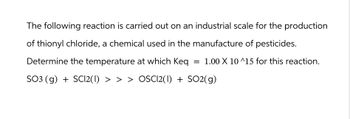
Chemistry
10th Edition
ISBN: 9781305957404
Author: Steven S. Zumdahl, Susan A. Zumdahl, Donald J. DeCoste
Publisher: Cengage Learning
expand_more
expand_more
format_list_bulleted
Concept explainers
Question

Transcribed Image Text:The following reaction is carried out on an industrial scale for the production
of thionyl chloride, a chemical used in the manufacture of pesticides.
Determine the temperature at which Keq = 1.00 X 10^15 for this reaction.
SO3 (g) + SC12(1) > > > OSC12(1) + SO2(g)
Expert Solution
This question has been solved!
Explore an expertly crafted, step-by-step solution for a thorough understanding of key concepts.
Step by stepSolved in 3 steps

Knowledge Booster
Learn more about
Need a deep-dive on the concept behind this application? Look no further. Learn more about this topic, chemistry and related others by exploring similar questions and additional content below.Similar questions
- Jj.62.arrow_forwardAt 1 atm and 78 oC, which of the following reactions does have ∆Hrxno < ∆Urxno, where ∆Hrxno is the enthalpy change of the reaction and ∆Urxno is the internal energy change of the reaction? Watch for the physical state of each species. Reaction (A): 2 C6H6 (liq) + 15 O2 (g) à 12 CO2 (g) + 6 H2O (liq) Reaction (B): Cu (s) + 2 H2SO4 (liq) à CuSO4 (aq) + SO2 (g) + 2 H2O (liq) Neither Reaction (A) nor (B) Both Reaction (A) and (B) Reaction (B) Reaction (A)arrow_forwardCalculate the total enthalpy change (kJ) for the following reaction: H2O (s, 90 g, –10. oC) --> H2O (l, 90 g, 10. oC) (The specific heat capacity of ice is 2.0 J/g×oC; the specific heat capacity of liquid water is 4.2 J/g×oC; the enthalpy of fusion for H2O at 0 oC is 6.0 kJ/mol.)arrow_forward
- 3- Diethyl ether (CH3CH2OCH2CH3) was one of the first chemicals used as an anesthetic. At 34.6°C, diethyl ether has a vapor pressure of 760. torr, and at 17.9°C, it has a vapor pressure of 400 torr. What is the ΔH of vaporization for diethyl ether?arrow_forwardThe Δ?vapΔHvap of a certain compound is 47.57 kJ·mol−147.57 kJ·mol−1 and its Δ?vapΔSvap is 67.46 J·mol−1·K−1.67.46 J·mol−1·K−1. What is the boiling point of this compound?arrow_forwardThe addition of 105.0 g potassium fluoride to 599.0 mL of water (d = 1.00 g/mL) causes the temperature to rise 3.21 °C. What is the ΔHrxn for KF? (Assume cp = 4.18 J/g oC.)arrow_forward
- Between CO2, and HF, which one is closest to an ideal gas and why?arrow_forward15 g of solid MgCl2 is mixed with 30 g of water in a calorimeter that absorbs no heat. Which equation calculates the temperature change? Question 16 options: (15 g / 53.49 g mol–1 × –159850 J mol–1) / (30 g × 4.184 J g–1 °C–1) (15 g / 53.49 g mol–1 × 159850 J mol–1) / (30 g × 4.184 J g–1 °C–1) –(15 g / 53.49 g mol–1 × –159850 J mol–1) / (45 g × 4.184 J g–1 °C–1)arrow_forwardDetermine the amount of heat (in kJ) given off when 2.56 g of NO2 is produced according to the following equation: 2NO(g) + O2(g) → 2NO2(g) ΔH = −114.6 kJ/mol Group of answer choices 3.19 kJ 5.56 kJ 6.38 kJ 1.14 kJ 114.6 kJarrow_forward
- Determine the enthalpy change of reaction at 25◦C for4 HNO3(ℓ) + 5 N2H4(ℓ)→7 N2(g) + 12 H2O(g)∆Hffor HNO3is−174.1 kJ/mol;∆Hf For H2O is−241.8 kJ/mol;∆Hffor N2H4is +50.63 kJ/mol. 1.1952.1 kJ/mol rxn 2.−3851.9 kJ/mol rxn 3.−2233.6 kJ/mol rxn 4.−3344.9 kJ/mol rxn 5.3344.9 kJ/mol rxn 6.−2458.4 kJ/mol rxnarrow_forwardA calorimeter contains 16.0 mLmL of water at 12.5 ∘C∘C . When 1.40 gg of XX (a substance with a molar mass of 75.0 g/molg/mol ) is added, it dissolves via the reaction X(s)+H2O(l)→X(aq)X(s)+H2O(l)→X(aq) and the temperature of the solution increases to 25.0 ∘C∘C . Calculate the enthalpy change, ΔHΔ�, for this reaction per mole of XX. Assume that the specific heat of the resulting solution is equal to that of water [4.18 J/(g⋅∘C)J/(g⋅∘C)], that density of water is 1.00 g/mLg/mL, and that no heat is lost to the calorimeter itself, nor to the surroundings. Express the change in enthalpy in kilojoules per mole to three significant figures.arrow_forward
arrow_back_ios
arrow_forward_ios
Recommended textbooks for you
 ChemistryChemistryISBN:9781305957404Author:Steven S. Zumdahl, Susan A. Zumdahl, Donald J. DeCostePublisher:Cengage Learning
ChemistryChemistryISBN:9781305957404Author:Steven S. Zumdahl, Susan A. Zumdahl, Donald J. DeCostePublisher:Cengage Learning ChemistryChemistryISBN:9781259911156Author:Raymond Chang Dr., Jason Overby ProfessorPublisher:McGraw-Hill Education
ChemistryChemistryISBN:9781259911156Author:Raymond Chang Dr., Jason Overby ProfessorPublisher:McGraw-Hill Education Principles of Instrumental AnalysisChemistryISBN:9781305577213Author:Douglas A. Skoog, F. James Holler, Stanley R. CrouchPublisher:Cengage Learning
Principles of Instrumental AnalysisChemistryISBN:9781305577213Author:Douglas A. Skoog, F. James Holler, Stanley R. CrouchPublisher:Cengage Learning Organic ChemistryChemistryISBN:9780078021558Author:Janice Gorzynski Smith Dr.Publisher:McGraw-Hill Education
Organic ChemistryChemistryISBN:9780078021558Author:Janice Gorzynski Smith Dr.Publisher:McGraw-Hill Education Chemistry: Principles and ReactionsChemistryISBN:9781305079373Author:William L. Masterton, Cecile N. HurleyPublisher:Cengage Learning
Chemistry: Principles and ReactionsChemistryISBN:9781305079373Author:William L. Masterton, Cecile N. HurleyPublisher:Cengage Learning Elementary Principles of Chemical Processes, Bind...ChemistryISBN:9781118431221Author:Richard M. Felder, Ronald W. Rousseau, Lisa G. BullardPublisher:WILEY
Elementary Principles of Chemical Processes, Bind...ChemistryISBN:9781118431221Author:Richard M. Felder, Ronald W. Rousseau, Lisa G. BullardPublisher:WILEY

Chemistry
Chemistry
ISBN:9781305957404
Author:Steven S. Zumdahl, Susan A. Zumdahl, Donald J. DeCoste
Publisher:Cengage Learning

Chemistry
Chemistry
ISBN:9781259911156
Author:Raymond Chang Dr., Jason Overby Professor
Publisher:McGraw-Hill Education

Principles of Instrumental Analysis
Chemistry
ISBN:9781305577213
Author:Douglas A. Skoog, F. James Holler, Stanley R. Crouch
Publisher:Cengage Learning

Organic Chemistry
Chemistry
ISBN:9780078021558
Author:Janice Gorzynski Smith Dr.
Publisher:McGraw-Hill Education

Chemistry: Principles and Reactions
Chemistry
ISBN:9781305079373
Author:William L. Masterton, Cecile N. Hurley
Publisher:Cengage Learning

Elementary Principles of Chemical Processes, Bind...
Chemistry
ISBN:9781118431221
Author:Richard M. Felder, Ronald W. Rousseau, Lisa G. Bullard
Publisher:WILEY